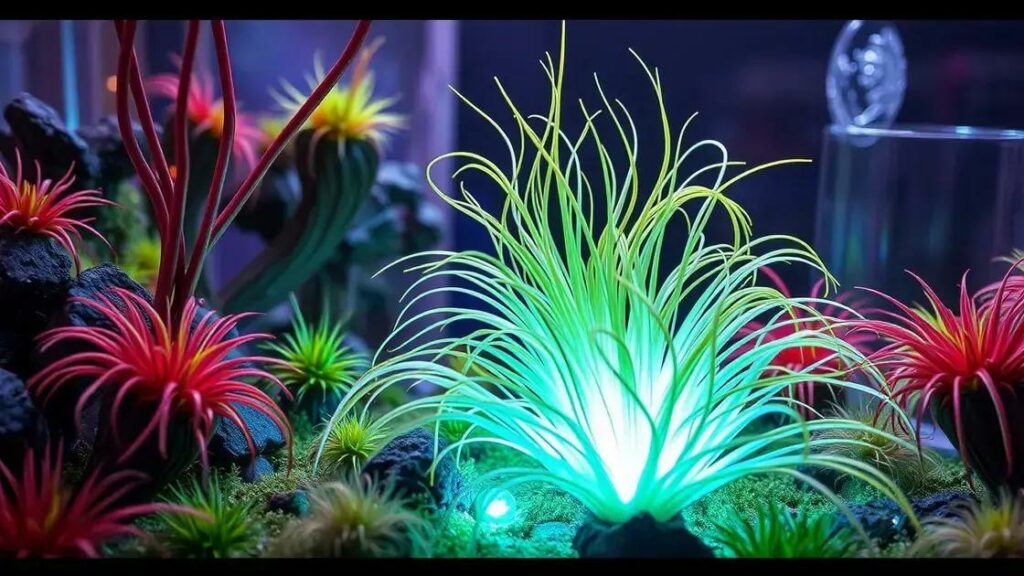How to care for a tillandsia air plant can be quite the adventure for plant enthusiasts! These unique plants require specific care routines to flourish. The right balance of moisture, light, and attention can make all the difference. Explore the essential tips and guidelines to ensure your tillandsia not only survives but thrives in your space!
Table of Contents
ToggleEssential watering needs for tillandsia
How to care for a tillandsia air plant requires a thorough understanding of its unique watering needs. Proper hydration is crucial for the overall health and vitality of these fascinating plants. Unlike traditional houseplants, tillandsias absorb moisture through their leaves rather than their roots. Therefore, their watering routine is vital for thriving growth.
Understanding tillandsia watering frequency
Watering tillandsias properly involves knowing their needs, which can vary based on environmental conditions. Here are some general guidelines:
- Water once a week, increasing during hot, dry seasons.
- In more humid environments, water every two weeks.
- Monitor the leaves’ color; if they appear dry or curled, it’s a sign they need more moisture.
Techniques for effective watering
There are a few effective methods to water your tillandsia:
- Soaking: Submerge the plant in room temperature water for about 30 minutes, then allow it to dry completely.
- Misting: Lightly spray the plant with water every few days, but ensure the leaves dry thoroughly afterward to prevent rot.
- Watering through a dish: Place the plant in a shallow dish of water, letting it absorb moisture through the leaves without soaking the base.
Signs of over- or under-watering
Recognizing the symptoms of improper watering is crucial:
- Under-watering: Leaves wilt, become dry, or develop a grayish hue.
- Over-watering: Leaves may turn yellow, become mushy, or appear translucent.
Common questions about watering tillandsias
- Can I use tap water to hydrate my tillandsia?
Yes, but it’s best to let it sit for 24 hours to allow chlorine to dissipate. - Do I need to water during winter?
Yes, but reduce the frequency, watering approximately every two weeks or as needed.
By following these tips on how to care for a tillandsia air plant, you can create a thriving environment for your air plants. For more indoor gardening techniques, consider exploring indoor gardening techniques.
Best light conditions for air plants

Best light conditions for air plants are vital for their survival and growth. Proper lighting mimics their natural habitat, enhancing their health and vibrancy. Tillandsias thrive in bright, indirect sunlight, which helps them convert sunlight into energy effectively.
Understanding light preferences
Tillandsias can adapt to various light conditions, but they perform best under the right circumstances. Here’s how to identify their ideal light:
- They prefer bright, indirect sunlight for at least 6 hours a day.
- Direct sunlight can lead to sunburn on the leaves, especially during the hottest part of the day.
- Low-light conditions can cause slow growth and may lead to developmental issues.
Optimal light sources
Utilizing artificial lighting can also benefit your air plants, especially in less sunny homes. Consider these options:
- LED grow lights: Energy-efficient and effective for providing the right spectrum of light.
- Fluorescent lights: Good for spreading light evenly when positioned correctly.
- Natural sunlight: Always the best option; place them near a window with filtered light.
Specific light conditions for thriving growth
Follow these tips to ensure your tillandsias are receiving the perfect amount of light:
- Rotate plants occasionally to ensure all sides receive light.
- Use sheer curtains to diffuse harsh sunlight during peak hours.
- Monitor their response to light; adjust positioning if leaves appear shriveled or too soft.
Common questions about lighting for air plants
- Can air plants survive in low light?
While they can tolerate lower light, growth will be slow and overall health may decline. - How do I know if my air plants are getting too much light?
Look for burned tips or discoloration on the leaves, which indicate excessive sunlight.
By understanding the best light conditions for air plants, you can create a thriving environment. For further tips on indoor gardening, check out exploring indoor gardening techniques.
Common issues and solutions for tillandsia care
Common issues and solutions for tillandsia care are essential for maintaining healthy air plants. Understanding potential challenges can ensure your tillandsias thrive in your home. These remarkable plants, while relatively low-maintenance, can encounter a few common issues that can impact their growth and overall appearance.
Identifying common problems with tillandsias
When caring for these air plants, it’s important to be aware of typical issues.
- Leaf discoloration: Yellow or brown tips can indicate over-watering or sunburn.
- Curling leaves: Often a sign of under-watering or insufficient humidity.
- Brown, mushy areas: This may suggest rot due to excess moisture or poor air circulation.
Solutions to common issues
For each problem, here are effective solutions:
- Leaf discoloration: Adjust light exposure and watering frequency to avoid direct sunlight and soggy conditions.
- Curling leaves: Increase watering frequency, ensuring the plant is thoroughly soaked if using soaking methods.
- Brown, mushy areas: Trim affected areas and reduce watering; ensure proper air circulation by placing the plant in a well-ventilated spot.
Preventive tips for healthy tillandsias
For long-term success, consider these preventive measures:
- Maintain ideal humidity levels around 40-60% for optimal growth.
- Ensure adequate air circulation by spacing plants appropriately.
- Monitor environmental changes, adjusting care as needed.
Frequently asked questions about tillandsia care
- How can I tell if my tillandsia is healthy?
Look for vibrant colors, firm leaves, and an overall lively appearance. - What should I do if my tillandsia isn’t flowering?
Ensure your plant is getting enough light and proper care; flowering can take time!
By addressing these common issues and solutions for tillandsia care, you can ensure your plants remain healthy and impressive. For more insights into indoor gardening, check out exploring indoor gardening techniques.
In conclusion
Caring for a tillandsia air plant can be a rewarding experience that enhances your indoor space. By mastering its unique needs, including proper watering, light conditions, and common issue solutions, you ensure these fascinating plants thrive in your home. Continue exploring tips and techniques to elevate your plant care skills, and don’t forget to check out tips on enhancing your indoor garden for more inspiration.

